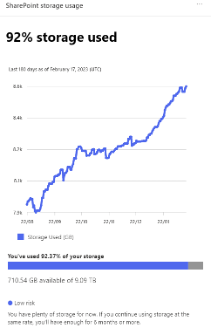Originally posted 26th February 2025
 Arun Puthanpurackal-Jose
4 minute read
Arun Puthanpurackal-Jose
4 minute read
 Arun Puthanpurackal-Jose
4 minute read
Arun Puthanpurackal-Jose
4 minute read
We are starting to see many organisations hit storage limits with SharePoint Online, What are the options when you see SharePoint storage growing, knowing it will at some point in the future exceed your available capacity?
 When Microsoft provisions your Microsoft 365 tenant, they allocate 1Tb of storage plus 10GB per user. So, for an organisation with 1,000 users, you would typically have 10.75TB of storage. That may sound like a lot, but as you migrate data to the cloud, it can quickly seem insufficient for your expected growth. Additionally, factors such as document versioning and meeting recordings contribute to increased storage usage.
When Microsoft provisions your Microsoft 365 tenant, they allocate 1Tb of storage plus 10GB per user. So, for an organisation with 1,000 users, you would typically have 10.75TB of storage. That may sound like a lot, but as you migrate data to the cloud, it can quickly seem insufficient for your expected growth. Additionally, factors such as document versioning and meeting recordings contribute to increased storage usage.
So, what happens when you approach your limit in SharePoint Online? The good news is that Microsoft allows you to exceed your allocated storage without immediately disrupting service. However, if no action is taken, Microsoft may eventually set your SharePoint Online sites to read-only mode, which could impact users' ability to work with the data.
Fortunately, there are several options available to manage and accommodate storage growth effectively.
When managing additional storage, they key strategy for any organisation facing rapid growth is to implement an effective content management system and a robust information architecture.
SharePoint Online offers several content management strategies to optimise data architecture. By utilising hub sites and a centralised managed metadata system, organisations can minimise data redundancy and reduce excess storage. A well-structured data framework not only simplifies monitoring and maintenance for administrators but also enhances the overall user experience.
However, they may be some instances where expanding the storage quota beyond the allocated limit becomes necessary. In such cases, the following options can be explored:
The first solution that many organisation consider is purchase additional storage from Microsoft for SharePoint Online. However, at an approximate cost of £0.20 per GB per month, this is not a cost-effective long-term option. The advantage is that organisations can increase or decrease their additional storage as needed, making this a viable short-term solution while planning a long-term strategy.
For long-term data storage, the primary solution to consider is Microsoft 365 Archive. While additional SharePoint storage costs around £0.20 per GB per month, this pay-as-you-go model allows organisations to move inactive data into a cold storage tier (archive) at a reduced rate - approximately £0.05 per GB per month.
Microsoft 365 Archive is managed through the SharePoint admin centre and can be controlled by SharePoint Administrators or Global Administrators.
A key benefit is that storage consumption charges only apply when the combined total of archived and active storage exceeds the included or licensed SharePoint storage capacity for the tenant. This means that archived sites do not incur additional storage costs unless the tenant has already exceeded its allocated quota.
However, there is currently a reactivation charge per GB when restoring an archived site—this applies if the reactivation occurs more than seven days after the site was archived. The seven-day grace period allows accidental archival to be reversed without incurring costs. Microsoft has announced plans to eliminate this restoration fee by March 2025. Alongside this change, there will be a new restriction preventing admins from re-archiving a SharePoint site that has been reactivated within the past 120 days.
Another option is to manage data disposition within SharePoint Online. This can be achieved using Retention Labels and Records File Plans available in Microsoft Purview. By implementing a well-structured file plan and applying policies to your sites, you can retain sensitive data required for legal compliance while deleting data that has not been modified for five years. This approach ensures that only current and necessary data remains in SharePoint Online, while outdated and redundant data is removed.

For some organisations, implementing Retention Labels and Records Files Plans may not be a comfortable solution. It is common for IT Directors to express concerns about deleting data due to potential future reference needs. Rather than debating the risks of deletion, the conversation often shifts towards Backup and Recovery solutions.
A Backup and Recovery solution allows you to ensure data is backed up and recoverable over various timeframes - whether for one day, one month, or even ten years - depending on your organisation's requirements and budget. This approach provides the security of knowing that deleted files can still be restored, making it easier to transition to Retention Labels in the future.
A more complex but still viable solution is to move files from SharePoint to more cost-effective Azure Storage locations. Currently, no built-in feature automatically moves data, so this process would require a custom solution. However, by transferring data, you could significantly reduce costs - from approximately £0.20 per GB per month in SharePoint to as little as £0.01 per GB per month using Azure Cool tier storage, or even less with the Archive tier.
If you are starting to experience storage capacity issues or would like to understand more on any of the above areas then please feel free to get in touch with our team.
Originally posted 26th February 2025